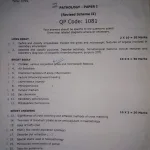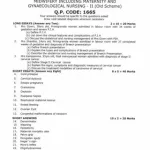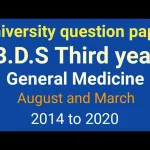The NTRUHS 3rd BDS examination is an important milestone for dental students. This guide provides previous question papers with detailed answers, covering all subjects to aid in effective preparation. These questions are designed to give insights into the exam pattern and strengthen your understanding of key topics.
General Medicine
Question: What are the causes of hypertension?
Answer: Hypertension can be caused by factors such as genetics, obesity, excessive salt intake, stress, lack of exercise, alcohol consumption, and underlying medical conditions like kidney disease.
Question: Explain the clinical features of diabetes mellitus.
Answer: Common clinical features include frequent urination, excessive thirst, increased hunger, weight loss, fatigue, and slow healing of wounds.
Question: Define anemia and its types.
Answer: Anemia is a condition where there is a reduced number of red blood cells or hemoglobin. Types include iron-deficiency anemia, megaloblastic anemia, and hemolytic anemia.
Question: What is jaundice, and what are its types?
Answer: Jaundice is the yellowing of the skin and eyes due to high bilirubin levels. Types include pre-hepatic, hepatic, and post-hepatic jaundice.
Question: What are the complications of hypertension?
Answer: Complications include stroke, heart attack, kidney damage, vision problems, and aneurysm.
Question: Describe the pathophysiology of myocardial infarction.
Answer: Myocardial infarction occurs due to the blockage of coronary arteries, leading to reduced blood flow and oxygen supply to the heart muscle, causing tissue damage.
Question: What is congestive heart failure and its symptoms?
Answer: Congestive heart failure is the inability of the heart to pump blood effectively. Symptoms include shortness of breath, fatigue, and swelling in legs and abdomen.
Question: Explain the causes of chronic kidney disease.
Answer: Causes include diabetes, hypertension, glomerulonephritis, polycystic kidney disease, and prolonged use of certain medications.
Question: What is bronchial asthma, and what are its triggers?
Answer: Bronchial asthma is a chronic inflammatory airway disease. Triggers include allergens, dust, smoke, infections, and cold air.
Question: Define cirrhosis and its causes.
Answer: Cirrhosis is scarring of the liver caused by chronic alcohol abuse, hepatitis B and C, or fatty liver disease.
Question: What are the clinical features of meningitis?
Answer: Symptoms include fever, headache, stiff neck, nausea, vomiting, and altered mental status.
Question: Explain the management of a patient with myocardial infarction.
Answer: Management includes administering oxygen, nitroglycerin, aspirin, beta-blockers, and immediate reperfusion therapy.
Question: What are the risk factors for coronary artery disease?
Answer: Risk factors include smoking, obesity, sedentary lifestyle, high cholesterol, hypertension, and diabetes.
Question: Define peptic ulcer disease and its complications.
Answer: Peptic ulcer disease involves sores in the stomach or duodenal lining. Complications include bleeding, perforation, and gastric outlet obstruction.
Question: What is Parkinson’s disease and its symptoms?
Answer: Parkinson’s disease is a neurodegenerative disorder. Symptoms include tremors, rigidity, bradykinesia, and postural instability.
Question: What are the diagnostic criteria for diabetes mellitus?
Answer: Diagnostic criteria include fasting glucose ≥126 mg/dL, HbA1c ≥6.5%, or random glucose ≥200 mg/dL with symptoms.
Question: What is hepatitis, and how is it classified?
Answer: Hepatitis is liver inflammation caused by viruses, alcohol, or drugs. It is classified as acute or chronic.
Question: Describe the complications of chronic obstructive pulmonary disease (COPD).
Answer: Complications include respiratory infections, lung cancer, pulmonary hypertension, and heart failure.
Question: What is hypothyroidism and its symptoms?
Answer: Hypothyroidism is an underactive thyroid gland. Symptoms include fatigue, weight gain, dry skin, cold intolerance, and depression.
Oral Pathology
Question: What are the common causes of oral cancer?
Answer: Causes include tobacco use, alcohol consumption, human papillomavirus (HPV) infection, and poor oral hygiene.
Question: Explain the pathogenesis of dental caries.
Answer: Dental caries occur due to bacterial plaque, sugar intake, and acid production, leading to enamel demineralization and cavity formation.
Question: What is leukoplakia and its clinical significance?
Answer: Leukoplakia is a white patch in the oral mucosa, often a precancerous lesion requiring monitoring and biopsy.
Question: Describe the histopathology of ameloblastoma.
Answer: Ameloblastoma is characterized by epithelial islands resembling enamel organ in a fibrous stroma, often seen in the jaw.
Question: What are the types of oral candidiasis?
Answer: Types include pseudomembranous, erythematous, hyperplastic, and angular cheilitis.
Question: Define aphthous ulcers and their causes.
Answer: Aphthous ulcers are painful sores in the oral cavity caused by stress, trauma, nutritional deficiencies, or allergies.
Question: What is lichen planus, and how does it present in the oral cavity?
Answer: Lichen planus is a chronic inflammatory condition. Oral presentations include white, lacy patches or erosive lesions.
Question: Describe the clinical features of squamous cell carcinoma in the oral cavity.
Answer: Features include non-healing ulcers, red or white patches, pain, and swelling.
Question: What are the radiographic features of dentigerous cysts?
Answer: Dentigerous cysts appear as well-defined radiolucent areas around the crown of an unerupted tooth.
Question: Explain the etiology of periodontal disease.
Answer: Periodontal disease is caused by bacterial plaque, poor oral hygiene, smoking, diabetes, and genetic factors.
Question: What is erythroplakia, and why is it significant?
Answer: Erythroplakia is a red patch in the oral mucosa, often associated with a high risk of malignancy.
Question: What are odontogenic keratocysts?
Answer: Odontogenic keratocysts are aggressive cystic lesions in the jaw, often associated with the nevoid basal cell carcinoma syndrome.
Question: Define xerostomia and its causes.
Answer: Xerostomia is dry mouth due to reduced saliva flow caused by medications, systemic diseases, or radiation therapy.
Question: What is pericoronitis?
Answer: Pericoronitis is inflammation of soft tissues around a partially erupted tooth, often the third molar.
Question: Describe the clinical features of oral submucous fibrosis.
Answer: Features include reduced mouth opening, burning sensation, and fibrous bands in the oral mucosa.
Question: What are the risk factors for oral thrush?
Answer: Risk factors include immunosuppression, antibiotics, diabetes, and wearing dentures.
Question: Explain the management of oral leukoplakia.
Answer: Management involves eliminating risk factors, regular monitoring, and surgical excision if dysplasia is present.
Question: What is the etiology of cleft lip and palate?
Answer: Cleft lip and palate result from genetic factors, environmental influences, and nutritional deficiencies during embryogenesis.
Question: What are the complications of untreated dental caries?
Answer: Complications include pulpitis, abscess formation, tooth loss, and systemic infections.
Question: Describe the features of amelogenesis imperfecta.
Answer: Amelogenesis imperfecta presents with defective enamel, leading to discolored, weak, and easily worn teeth.
The NTRUHS 3rd BDS question paper collection provides a comprehensive understanding of important concepts. Practice and review these questions regularly to enhance your knowledge and exam preparation. Tailored subject-wise, this resource helps you confidently tackle the exams.
Latest Posts
- Step-by-step guide to download and apply for jee mains admit card 202
- Comprehensive 2025 government holidays and recruitment details for job seekers
- JEE Mains Admit Card 2025: Your Step-by-Step Guide to Downloading the Hall Ticket
- Everything You Need to Know About 2025 Government Holidays Recruitment
- Comprehensive Guide to rrb d group recruitment 2025 – Eligibility, Vacancies, and Application
- Detailed guide to nps trust recruitment 2025 vacancies, eligibility and apply process
- Comprehensive guide to hpcl recruitment 2025 notification, vacancies, and application process
- ignou bed admission 2025 complete recruitment guide with eligibility and process
- Comprehensive Guide to Indian Army Agniveer Recruitment 2025 Notification and Jobs
- Everything You Must Know About CBSE Board Exams 2025 Changes & New Rules






